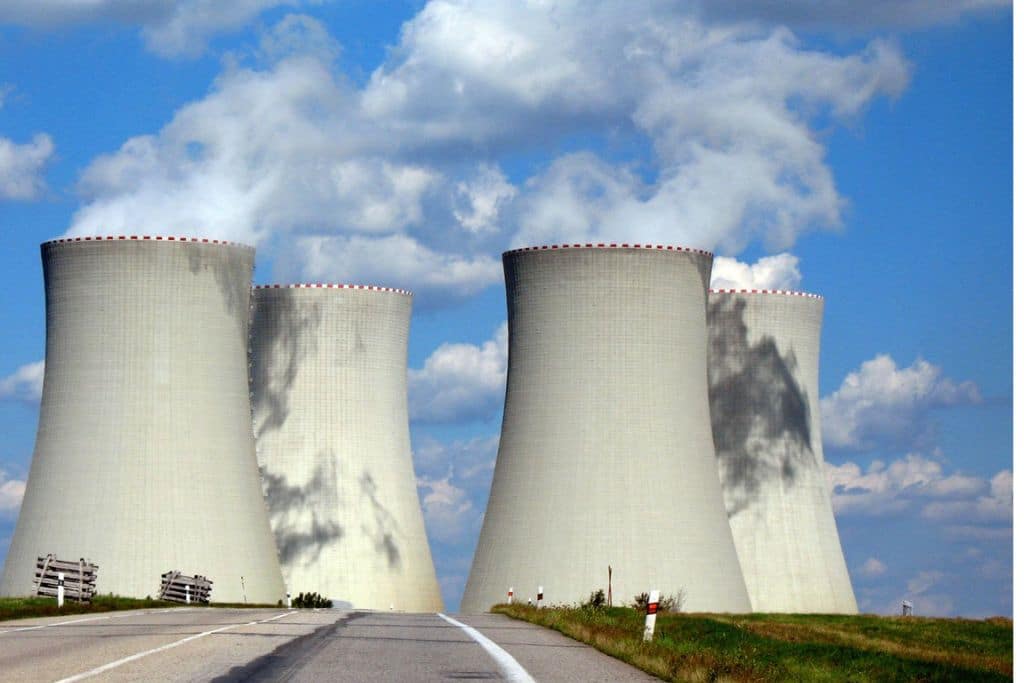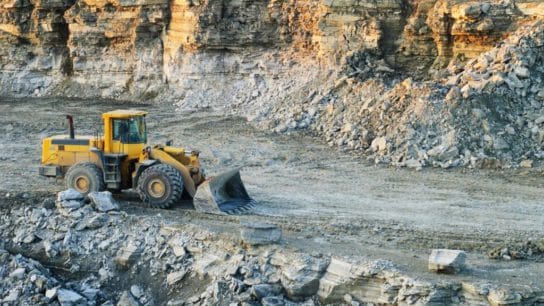Since the first nuclear plant started operations in the 1950s, the world has been highly divided on nuclear as a source of energy. While it is a cleaner alternative to fossil fuels, this type of power is also associated with some of the world’s most dangerous and deadliest weapons, not to mention nuclear disasters. The extremely high cost and lengthy process to build nuclear plants are compensated by the fact that producing nuclear energy is not nearly as polluting as oil and coal. In the race to net-zero carbon emissions, should countries still rely on nuclear energy or should they make space for more fossil fuels and renewable energy sources? We take a look at the advantages and disadvantages of nuclear energy.
—
What Is Nuclear Energy?
Nuclear energy is the energy source found in an atom’s nucleus, or core. Once extracted, this energy can be used to produce electricity by creating nuclear fission in a reactor through two kinds of atomic reaction: nuclear fusion and nuclear fission. During the latter, uranium used as fuel causes atoms to split into two or more nuclei. The energy released from fission generates heat that brings a cooling agent, usually water, to boil. The steam deriving from boiling or pressurised water is then channelled to spin turbines to generate electricity. To produce nuclear fission, reactors make use of uranium as fuel.
For centuries, the industrialisation of economies around the world was made possible by fossil fuels like coal, natural gas, and petroleum and only in recent years countries opened up to alternative, renewable sources like solar and wind energy. In the 1950s, early commercial nuclear power stations started operations, offering to many countries around the world an alternative to oil and gas import dependency and a far less polluting energy source than fossil fuels. Following the 1970s energy crisis and the dramatic increase of oil prices that resulted from it, more and more countries decided to embark on nuclear power programmes. Indeed, most reactors have been built between 1970 and 1985 worldwide. Today, nuclear energy meets around 10% of global energy demand, with 439 currently operational nuclear plants in 32 countries and about 55 new reactors under construction. In 2020, 13 countries produced at least one-quarter of their total electricity from nuclear, with the US, China, and France dominating the market by far.

Fossil fuels make up 60% of the United States’ electricity while the remaining 40% is equally split between renewables and nuclear power. France embarked on a sweeping expansion of its nuclear power industry in the 1970s with the ultimate goal of breaking its dependence on foreign oil. In doing this, the country was able to build up its economy by simultaneously cutting its emissions at a rate never seen before. Today, France is home to 56 operating reactors and it relies on nuclear power for 70% of its electricity.
You might also like: A ‘Breakthrough’ In Nuclear Fusion: What Does It Mean for the Future of Energy Generation?
Advantages of Nuclear Energy
France’s success in cutting down emissions is a clear example of some of the main advantages of nuclear energy over fossil fuels. First and foremost, nuclear energy is clean and it provides pollution-free power with no greenhouse gas emissions. Contrary to what many believe, cooling towers in nuclear plants only emit water vapour and are thus, not releasing any pollutant or radioactive substance into the atmosphere. Compared to all the energy alternatives we currently have on hand, many experts believe that nuclear energy is indeed one of the cleanest sources. Many nuclear energy supporters also argue that nuclear power is responsible for the fastest decarbonisation effort in history, with big nuclear players like France, Saudi Arabia, Canada, and South Korea being among the countries that recorded the fastest decline in carbon intensity and experienced a clean energy transition by building nuclear reactors and hydroelectric dams.
Earlier this year, the European Commission took a clear stance on nuclear power by labelling it a green source of energy in its classification system establishing a list of environmentally sustainable economic activities. While nuclear energy may be clean and its production emission-free, experts highlight a hidden danger of this power: nuclear waste. The highly radioactive and toxic byproduct from nuclear reactors can remain radioactive for tens of thousands of years. However, this is still considered a much easier environmental problem to solve than climate change. The main reason for this is that as much as 90% of the nuclear waste generated by the production of nuclear energy can be recycled. Indeed, the fuel used in a reactor, typically uranium, can be treated and put into another reactor as only a small amount of energy in their fuel is extracted in the fission process.
A rather important advantage of nuclear energy is that it is much safer than fossil fuels from a public health perspective. The pro-nuclear movement leverages the fact that nuclear waste is not even remotely as dangerous as the toxic chemicals coming from fossil fuels. Indeed, coal and oil act as ‘invisible killers’ and are responsible for 1 in 5 deaths worldwide. In 2018 alone, fossil fuels killed 8.7 million people globally. In contrast, in nearly 70 years since the beginning of nuclear power, only three accidents have raised public alarm: the 1979 Three Mile Island accident, the 1986 Chernobyl disaster and the 2011 Fukushima nuclear disaster. Of these, only the accident at the Chernobyl nuclear plant in Ukraine directly caused any deaths.
Finally, nuclear energy has some advantages compared to some of the most popular renewable energy sources. According to the US Office of Nuclear Energy, nuclear power has by far the highest capacity factor, with plants requiring less maintenance, capable to operate for up to two years before refuelling and able to produce maximum power more than 93% of the time during the year, making them three times more reliable than wind and solar plants.
You might also like: Nuclear Energy: A Silver Bullet For Clean Energy?
Disadvantages of Nuclear Energy
The anti-nuclear movement opposes the use of this type of energy for several reasons. The first and currently most talked about disadvantage of nuclear energy is the nuclear weapon proliferation, a debate triggered by the deadly atomic bombing of the Japanese cities of Hiroshima and Nagasaki during the Second World War and recently reopened following rising concerns over nuclear escalation in the Ukraine-Russia conflict. After the world saw the highly destructive effect of these bombs, which caused the death of tens of thousands of people, not only in the impact itself but also in the days, weeks, and months after the tragedy as a consequence of radiation sickness, nuclear energy evolved to a pure means of generating electricity. In 1970, the Treaty on the Non-Proliferation of Nuclear Weapons entered into force. Its objective was to prevent the spread of such weapons to eventually achieve nuclear disarmament as well as promote peaceful uses of nuclear energy. However, opposers of this energy source still see nuclear energy as being deeply intertwined with nuclear weapons technologies and believe that, with nuclear technologies becoming globally available, the risk of them falling into the wrong hands is high, especially in countries with high levels of corruption and instability.
As mentioned in the previous section, nuclear energy is clean. However, radioactive nuclear waste contains highly poisonous chemicals like plutonium and the uranium pellets used as fuel. These materials can be extremely toxic for tens of thousands of years and for this reason, they need to be meticulously and permanently disposed of. Since the 1950s, a stockpile of 250,000 tonnes of highly radioactive nuclear waste has been accumulated and distributed across the world, with 90,000 metric tons stored in the US alone. Knowing the dangers of nuclear waste, many oppose nuclear energy for fears of accidents, despite these being extremely unlikely to happen. Indeed, opposers know that when nuclear does fail, it can fail spectacularly. They were reminded of this in 2011, when the Fukushima disaster, despite not killing anyone directly, led to the displacement of more than 150,000 people, thousands of evacuation/related deaths and billions of dollars in cleanup costs.
Lastly, if compared to other sources of energy, nuclear power is one of the most expensive and time-consuming forms of energy. Nuclear plants cost billions of dollars to build and they take much longer than any other infrastructure for renewable energy, sometimes even more than a decade. However, while nuclear power plants are expensive to build, they are relatively cheap to run, a factor that improves its competitiveness. Still, the long building process is considered a significant obstacle in the run to net-zero emissions that countries around the world have committed to. If they hope to meet their emission reduction targets in time, they cannot afford to rely on new nuclear plants.
You might also like: The Nuclear Waste Disposal Dilemma
Who Wins the Nuclear Debate?
There are a multitude of advantages and disadvantages of nuclear energy and the debate on whether to keep this technology or find other alternatives is destined to continue in the years to come. Nuclear power can be a highly destructive weapon, but the risks of a nuclear catastrophe are relatively low. While historic nuclear disasters can be counted on the fingers of a single hand, they are remembered for their devastating impact and the life-threatening consequences they sparked (or almost sparked). However, it is important to remember that fossil fuels like coal and oil represent a much bigger threat and silently kill millions of people every year worldwide. Another big aspect to take into account, and one that is currently discussed by global leaders, is the dependence of some of the world’s largest economies on countries like Russia, Saudi Arabia, and Iraq for fossil fuels. While the 2011 Fukushima disaster, for example, pushed the then-German Chancellor Angela Merkel to close all of Germany’s nuclear plants, her decision only increased the country’s dependence on much more polluting Russian oil. Nuclear supporters argue that relying on nuclear energy would decrease the energy dependency from third countries. However, raw materials such as the uranium needed to make plants function would still need to be imported from countries like Canada, Kazakhstan, and Australia. The debate thus shifts to another problem: which countries should we rely on for imports and, most importantly, is it worth keeping these dependencies?
This story is funded by readers like you
Our non-profit newsroom provides climate coverage free of charge and advertising. Your one-off or monthly donations play a crucial role in supporting our operations, expanding our reach, and maintaining our editorial independence.
About EO | Mission Statement | Impact & Reach | Write for us


















